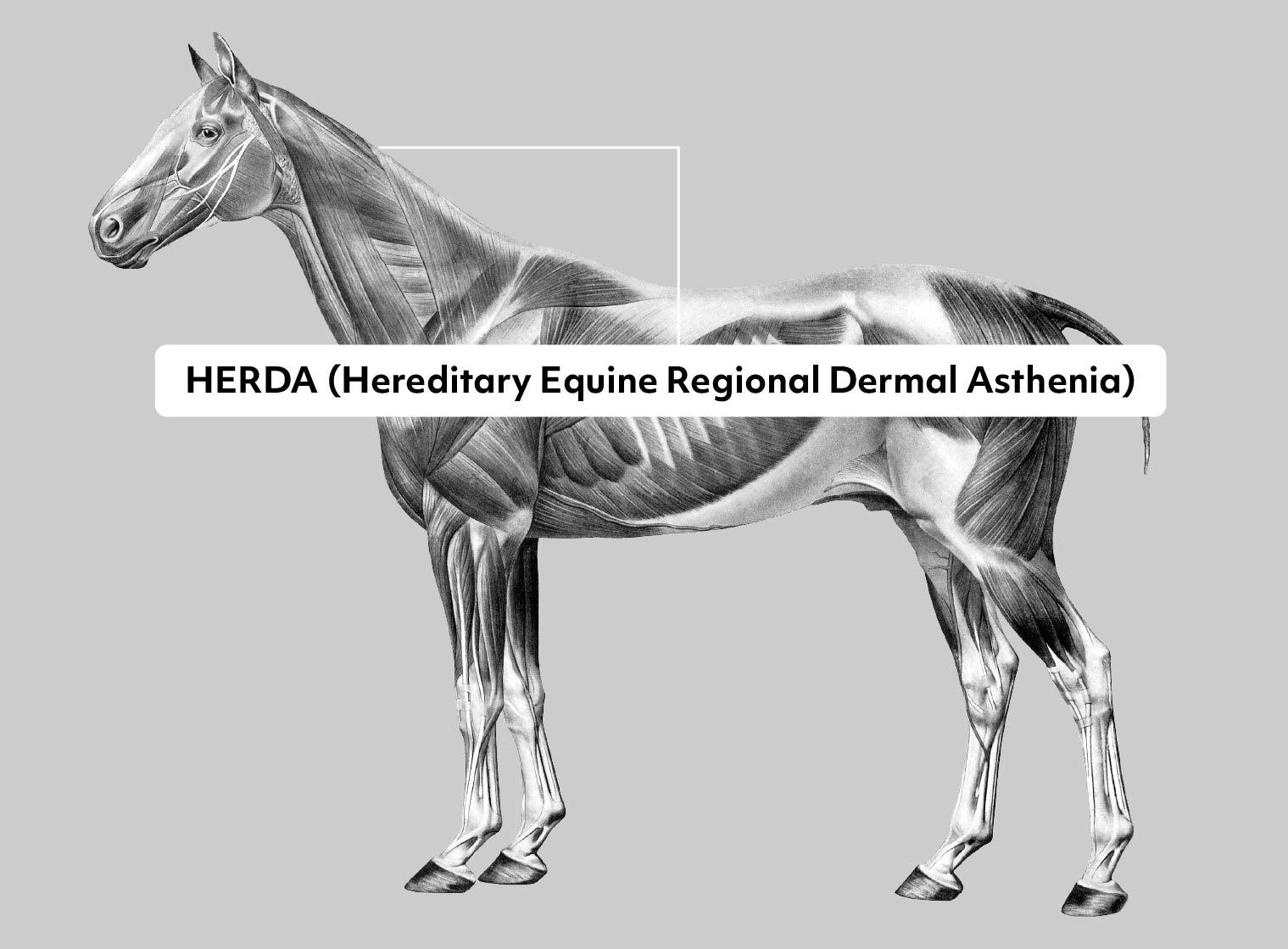Hereditary Equine Regional Dermal Asthenia (HERDA)
Gene or Region: PPIB
Reference Variant: G
Mutant Variant: A
Affected Breeds: Quarter Horse
Research Confidence: High - Findings reproduced in multiple studies
Explanation of Results: herda/herda = homozygous for Hereditary Equine Regional Dermal Asthenia, trait expressed, may result in severe/fatal health issues herda/n = heterozygous for Hereditary Equine Regional Dermal Asthenia, carrier n/n = no variant detected
General Description for Hereditary Equine Regional Dermal Asthenia (HERDA)
Hereditary Equine Regional Dermal Asthenia (HERDA) is a degenerative skin disease that primarily affects the American Quarter Horse breed. Loose skin is often an early indication of the disease, and severe seromas, hematomas, ulcerations usually develop around 1.5 years of age and progressively worsen. There is no cure, and the majority of affected animals have to be euthanized within 2-4 years.
A missense mutation in the equine cyclophilin B (PPIB) was determined to cause a functional defect in this protein, resulting in less effective catalysis of the rate-limiting step in collagen folding. Etalon offers diagnostic testing to determine carrier or affected status.
This disease follows an autosomal recessive mode of inheritance, so in order for the foal to be affected, both the sire and the dam must carry the allele. This also means that horses can appear normal but be carriers for the condition. If two carrier horses mate, there is a 25% chance that the foal will have HERDA. Studies estimate that ~3.5% of Quarter Horses are carriers. It's recommended that both carriers and clinically affected horses with HERDA be removed from breeding programs.
References
Tryon et al., “Homozygosity mapping approach identifies a missense mutation in equine cyclophilin B (PPIB) associated with HERDA in the American Quarter Horse.” (2007) Genomics 90: 93-102. PMID: 17498917
Ishikawa Y, Vranka JA, Boudko SP, Pokidysheva E, Mizuno K, Zientek K, Keene DR, Rashmir-Raven AM, Nagata K, Winand NJ, Bächinger HP. Mutation in cyclophilin B that causes hyperelastosis cutis in American Quarter Horse does not affect peptidylprolyl cis-trans isomerase activity but shows altered cyclophilin B-protein interactions and affects collagen folding. J Biol Chem. 2012 Jun 22;287(26):22253-65. doi: 10.1074/jbc.M111.333336. Epub 2012 May 3. PMID: 22556420; PMCID: PMC3381186.
More Horse Health
Lordosis
Lordosis (L1, L2, L3, L4), also known as "Swayback", is a curvature or dip in the spine that is often seen in older horses. However, in the American Saddlebred, this condition also affects younger horses. These animals do not appear to experience pain from their condition and are still able to be used under saddle.
Malignant Hyperthermia
Malignant hyperthermia (MH) is a muscle disorder in which anesthesia, stress, or extreme exercise trigger a hyperthermic state. Symptoms include high temperature, increased heart rate, high blood pressure, sweating, acidosis, and muscle rigidity. If symptoms are not immediately resolved, death is likely to occur.
Myosin-Heavy Chain Myopathy
Myosin-Heavy Chain Myopathy (MY; previously "IMM") is a genetic muscle disease found most commonly in stock-type horses that can result in two different presentations, Immune-Mediated Myositis (IMM) and Nonexertional Rhabdomyolysis “tying up,” which are both characterized by muscle damage or loss. Both presentations are associated with the same genetic variant. Horses with MYHM may exhibit one or both presentations at different times in their lives, although some horses carrying the variant might not display any symptoms at all.
Myotonia
Myotonia (MYT) is a rare disorder involving a slowed relaxation of muscles after contraction. The most well-known example of myotonia is “fainting goats,” a breed that is characterized by sudden rigidy and/or falling over when startled. In the single documented horse, this resulted in a protruding third eyelid when excited, as well as problems with muscle stiffness.
